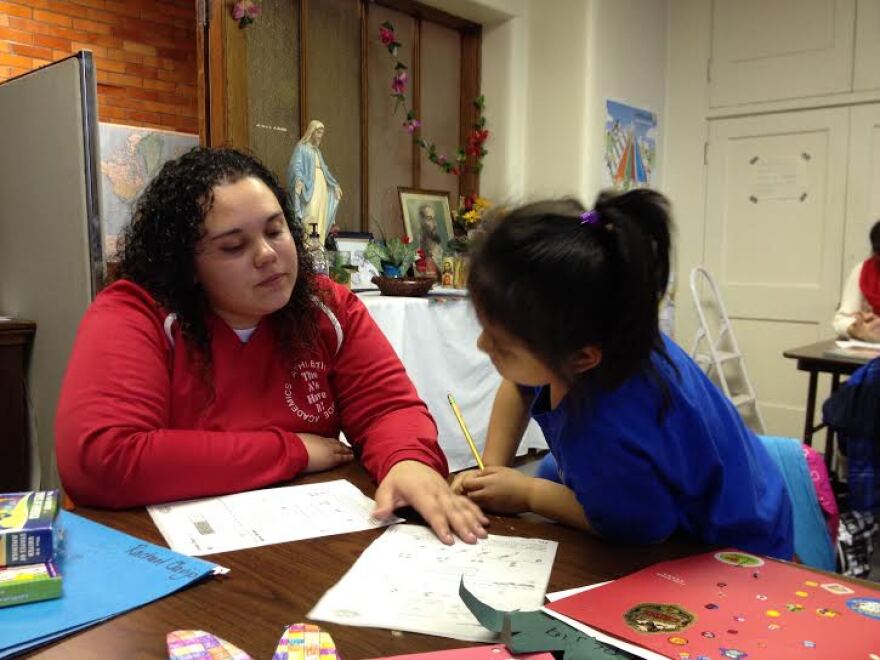It’s pretty much accepted by education researchers that preschool attendance has positive long term effects—people who go to preschool are more likely to be successful in K-12 education and to adapt socially to being around other kids. Yet, preschool numbers for Latino kids nationally and in Ohio are lower than other ethnic groups.
The Educational Track
The Center for American Progress finds 63 percent of Latino kids age three and four don't attend preschool, and Dawn Wallace-Pascoe with Children’s Defense Fund, Ohio (CDF) says, when it comes to education, “we’re not doing enough to get children of color, both Blacks and Latino Children on track educationally.”
Getting on track early means being kindergarten ready. But, according to a Kids Count report from the Annie E. Casey Foundation around 41 percent of economically disadvantaged Latino kids in Ohio aren't coming in ready for Kindergarten. The numbers also aren’t great for Black children at 29 percent. For Asian children, the number is 21% Asians and for white children, 16 percent aren’t kindergarten-ready.

Wallace-Pascoe says starting out unprepared has long-term effects.
“Children who don’t meet benchmarks, such as Third Grade Reading are less likely to graduate high school, which then also has long term effects on health, their ability to find good jobs and a whole host of things that you don’t necessarily think of when you’re thinking about sending your child to preschool.”
Getting Kids 'Kindergarten Ready'
One place helping young children get on track early is the Twin Towers Head Start classroom in Dayton, part of the Miami Valley Childhood Development Centers. At lunchtime on any given weekday, around a dozen children and their teachers can be found sitting at low-set tables talking about fun stuff - mornings and afternoons are filled with physical and educational play activities.
The kids here come from lots of different backgrounds, and Amanda Looney says she felt intimidated when she first started teaching here.
“I walked into the classroom and a lot of the students didn’t speak English as a first language. I had a lot of Turkish and Spanish and Arabic, and maybe just a handful of English speaking students.”
But Looney says the children made her feel at ease—she learned how quickly little kids pick up on language. “It’s really interesting to see them all blend together, and you’ll see the Turkish students learn to speak Spanish so they can play with their Latino friends.”
Assistant bilingual teacher, Nery Millan, says language is really important in early education.
“Me being bilingual—Spanish speaking only at home when I was young—there was no one there to help me with homework or anything. My Mom, my dad didn’t know any English.”

Now Millan is passionate about helping others in similar situations.
“I love it, I love it. I love to help out children. I love knowing that their parents know that there’s someone here who speaks their language, that can help them out when they need it and teach them English.”
Bridging The Gap
Language and cultural barriers can follow Latino students throughout their K-12 education. That's where organizations like El Puente Educational Center in Dayton come in. Alyssa Wagner is the program director for the after school language tutoring program for Kindergarten through 6th grade.
“El Puente in English means 'the bridge' and that really is our mission," she says. "To be kind of that connecting point between American culture and Latino culture, and help to bridge the differences and connect schools and families together.”

Wagner says there are a number of reasons Latino children might not go to preschool including, "parents having to work full-time and preschool mostly being offered for half-day, for that cultural aspect of my kids too ‘chaquito,’ they're too little, too small to leave the home."
She adds that a lot of it may be access to preschools geared to help Latino children, or parents "don't know how important it is."
El Puente and other community groups are trying to get the word out about early education for Latinos, but Wagner admits they have a long way to go.
Graduating Latino is WYSO's series on education for Latino students in the Miami Valley, produced in partnership with Think TV. It's part of the public media initiative American Graduate, which is funded by the Corporation for Public Broadcasting.


